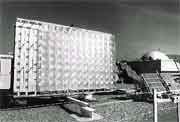Shine a light
 a major breakthrough involving commercial solar power generation will make it very popular. A proposal has been made to use amorphous silicon instead of the traditional crystalline silicon in solar cells. The cheaper amorphous silicon promises to bring down the cost of power generation, the sole factor that has prevented large-scale use of solar power.
a major breakthrough involving commercial solar power generation will make it very popular. A proposal has been made to use amorphous silicon instead of the traditional crystalline silicon in solar cells. The cheaper amorphous silicon promises to bring down the cost of power generation, the sole factor that has prevented large-scale use of solar power.
Attempts to electrify villages and run petrol pumps on solar power have been confined to the experimental stage in the us . Solar power became popular briefly after the oil crisis of the 1970s. But the high costs always proved too discouraging to adopt this easily available non-conventional source of energy.
At present, the worldwide production of electricity from solar cells stands at 96 megawatt ( mw ) per year. Of this, about 45 mw is produced in the us . A large chunk of this production is exported to developing countries. If the claim of researchers at the Materials Research Society Conference, San Francisco, holds water, solar power may have a better future. Amorphous silicon is not only cheap but easier to process into the solar cells.
How could this be achieved, especially since amorphous silicon is in a powder form and essentially disorderly? Power is generated when the silicon in solar cells absorbs photons of light and converts their energy into a flow of electrons. Solar cells using crystalline silicon do this with an efficiency of 12 per cent.
However, the efficiency of amorphous silicon cells is generally poor. Light degrades the panels, which lose about 30 per cent of their energy due to a phenomenon called Staebler-Wronsky effect, whereby the loose chemical bonding in silicon atoms sucks up some of the electrons freed by light.
Three or four ways to limit this effect have been discovered so far. Addition of hydrogen gas to silicon cells to cap off many dangling bonds, using multiple layers of silicon to capture a broader spectrum of light, and adding traces of germanium to absorb longer wavelengths are some of the methods combined by the manufacturers to produce amorphous silicon cells with an efficiency of a record 14.6 per cent. This would decline to 13 per cent after 1,000 hours of use.
The companies which market the amorphous silicon panels include Canon of Japan, Solarex Corporation of Pennsylvania and United Solar System Corporation of the us.
The most important factor that would lower the cost of solar cells is the quantum of sales. The production of solar cells is caught up in the vicious circle wherein the costs are high as the sales are low and the sales are low because the costs are very high. An assured sale is what the manufacturers are hoping for. As it is, the product is not particularly popular commercially.
A recent development in California should come as a shot in the arm for combating the high costs of solar power. The Sacramento Municipal Utility District of California has signed a big contract to buy solar cells. This would push the costs down to a competitive level by the year 2002. Under the contract, the California utility will buy solar cells to produce 10 mw of power by 2002 to supply electricity to hundreds of customers. The district expects to buy solar cells in 1998 at a cost equal to 16.3 cents per kilowatt ( kw ) hour. The price is expected to fall considerably by the final year of the contract.
The gesture by the California utility will go a long way in popularising the concept. The utility will put up solar panels on the roofs of 4,000 houses. These will produce about three kw of power during the day. At present, 700 customers have these installations.
Similarly, British Petroleum
Related Content
- Global food 50/50 report 2023/2024
- New data shine light on gender gaps in the labour market
- Compendium of best practices on climate action from Indian states
- Chilling prospects: tracking sustainable cooling for all 2022
- Community forest rights and the pandemic: Gram Sabhas lead the way
- Drivers of change of relevance for Europe's environment and sustainability
